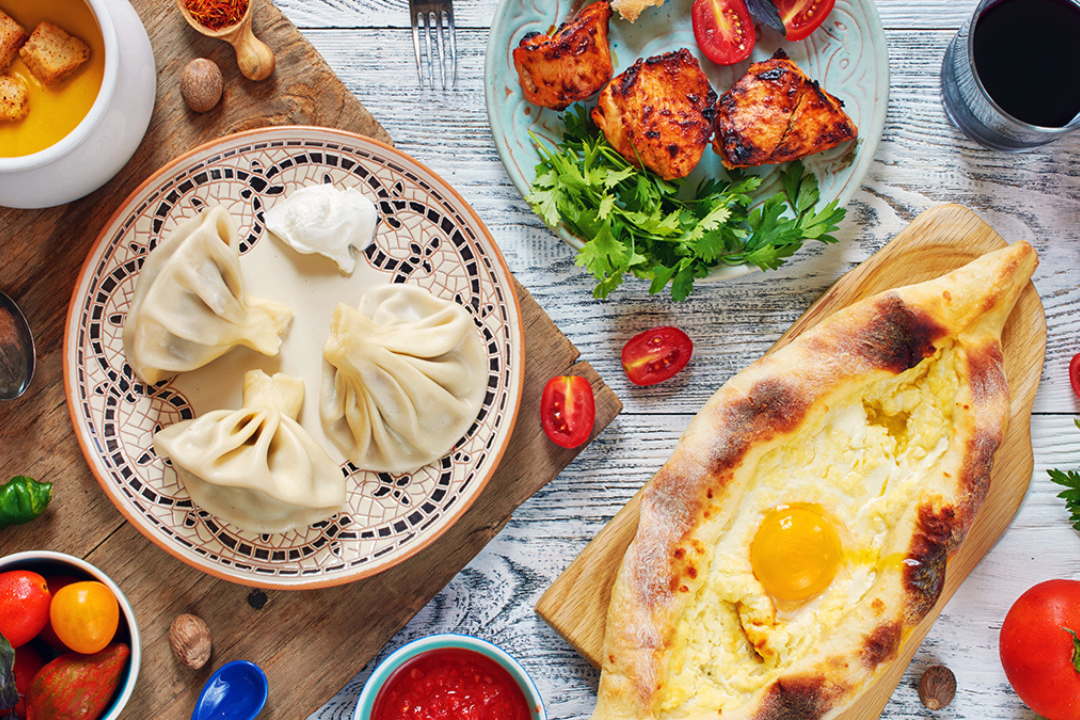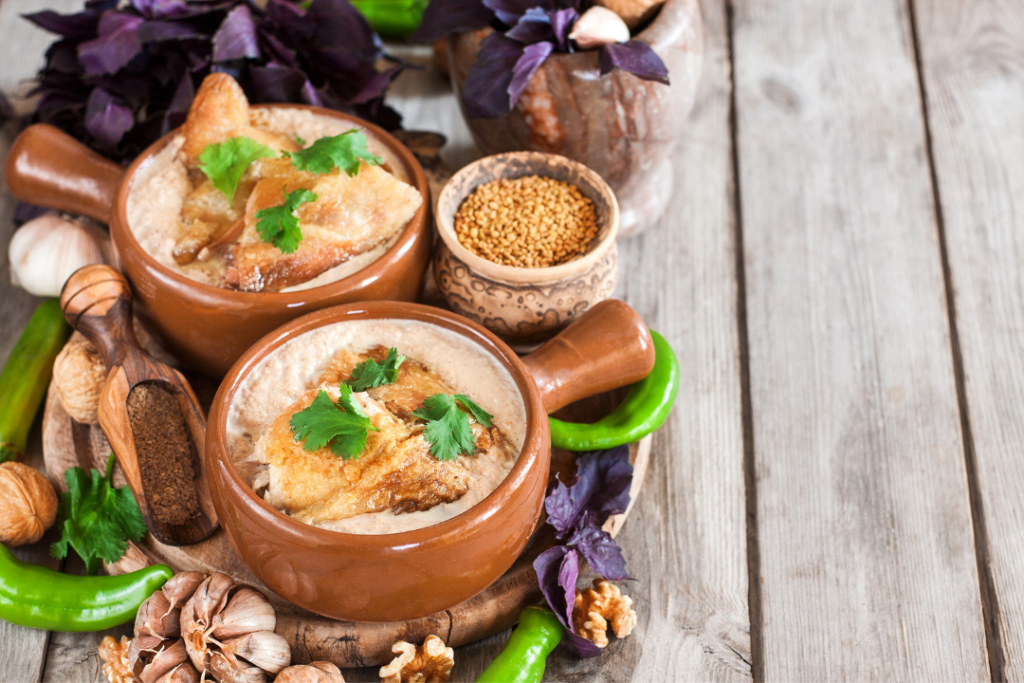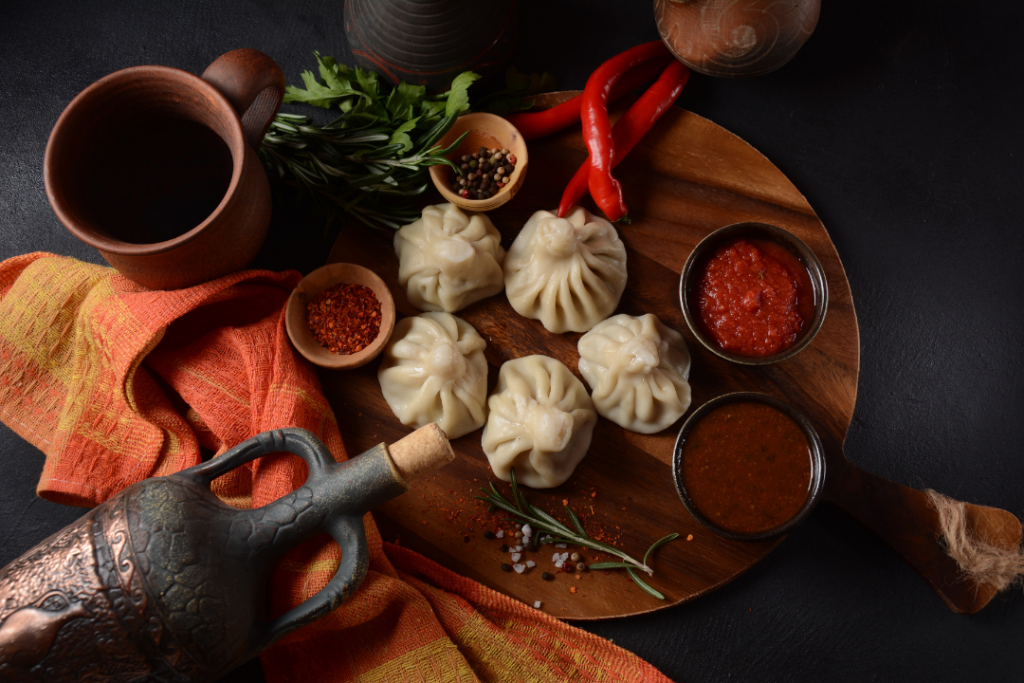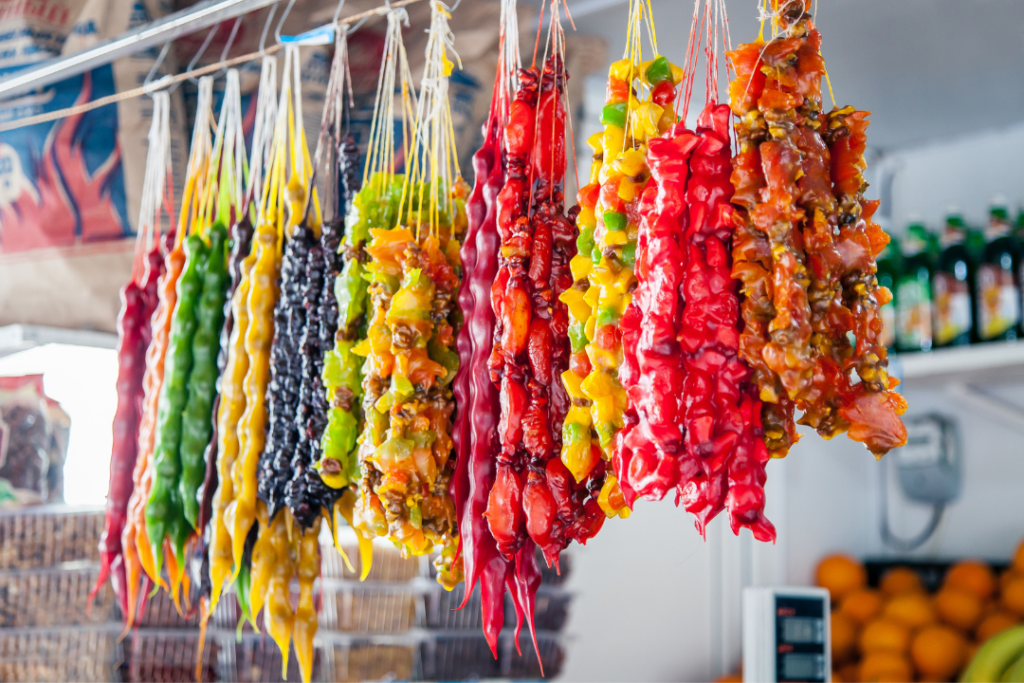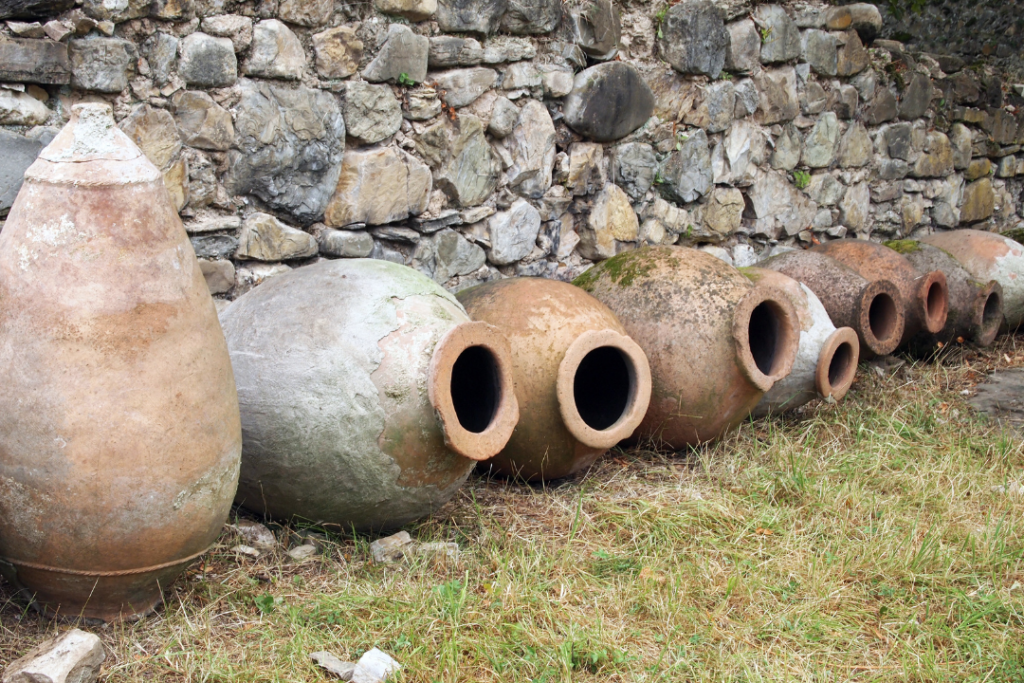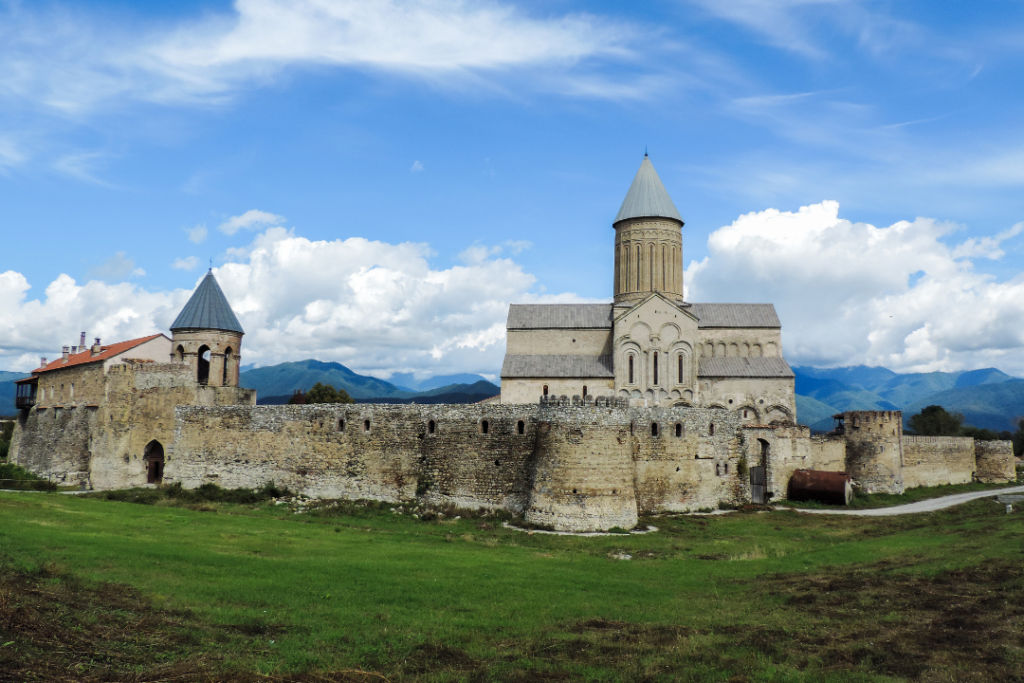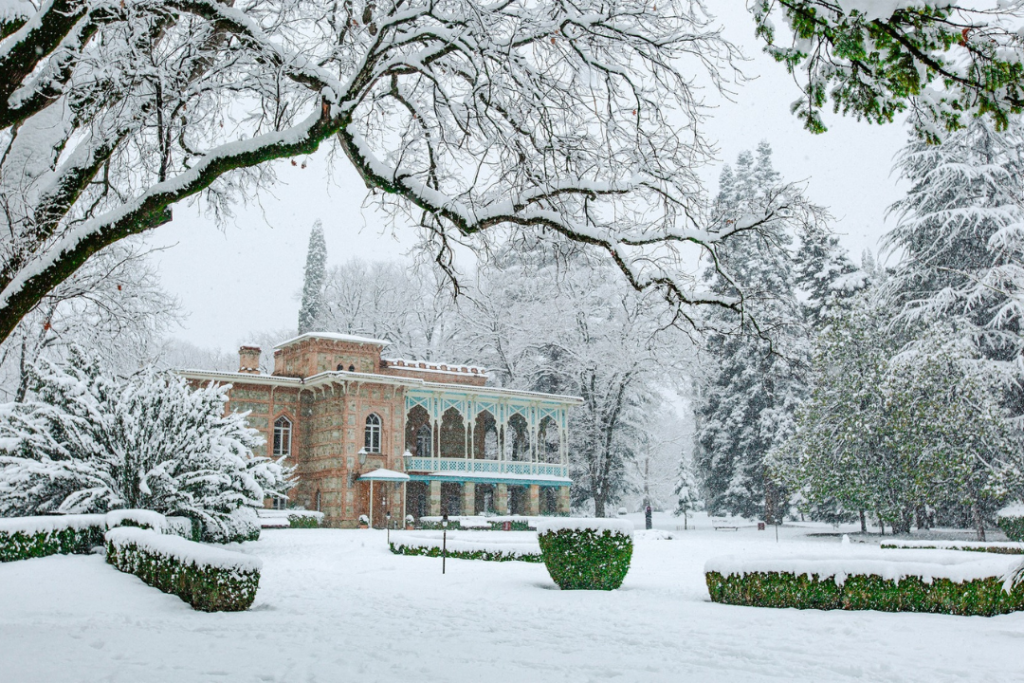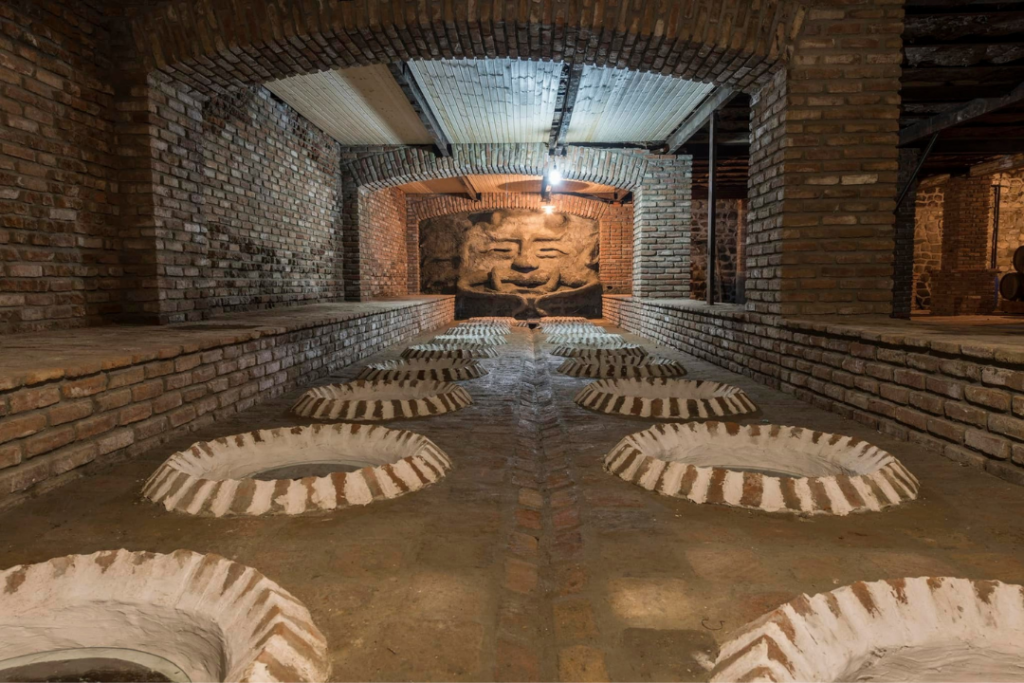Georgia is also known for its natural beauty. The Caucasus Mountains provide a stunning backdrop to many parts of the country. It’s an excellent destination for those looking for an off-the-beaten-path travel experience. I highly recommend seeking out these alternative destinations to avoid crowds and have truly unique experiences.
GET TO KNOW GEORGIA THROUGH ITS CUISINE
Georgian cuisine is one of the most diverse and unique in the world. The country has three distinct cuisines: Imeretian, Megrelian, and Kakhetian.
Imeretian cuisine is known for its generous use of herbs and spices. This cuisine uses walnuts, hazelnuts, and garlic to flavor their dishes. Those are some of my favorites so everything must be delicious!
Megrelian cuisine uses a lot of lamb, beef, pork, and chicken, as well as cheese and yogurt.
Kakhetian cuisine has more similarities with Megrelian cuisine than Imeretian cuisine because they both use a lot of lamb, beef, and pork.
WHEN IN GEORGIA: MUST TRY DISHES!
Khachapuri
A staple dish in Georgia. It consists of cheese baked inside bread dough. Khachapuri is a photogenic food that #khachapuri generates thousands of Instagram results!
Pkhali (or pkhaleuli)
This traditional Georgian dish is made from finely chopped vegetables mixed with ground walnuts and spices. The vegetables are typically blanched or sautéed first, then mashed and combined with the ground walnuts and spices.
It is a popular appetizer. It’s often served cold, formed into small balls or patties, and garnished with fresh herbs.
Satsivi
A traditional Georgian dish made from poultry, fish, or game meat that is poached and then coated in a walnut-based sauce. The sauce is made from ground walnuts, garlic, and spices such as coriander, blue fenugreek, and cilantro and is sometimes thickened with breadcrumbs or flour. The dish is served cold, as an appetizer or a main course, and is often garnished with fresh herbs.
Satsivi can be made with different types of meat, but the most common is chicken (chicken satsivi) and turkey (turkey satsivi). It is also a popular dish during Christmas and New Year’s celebrations in Georgia.
The dish is also known for its medicinal properties, and it’s said that it’s an excellent remedy for colds and flu.
Khinkali
A traditional Georgian dumpling filled with meat, pork or beef, and spices. The dumplings are typically made by hand by shaping a ball of dough around a filling of meat and spices. The dough is made from flour, water, and salt and is rolled out into thin circles. The meat filling is typically made from ground beef, pork, onions, and spices.
The dumplings are then pinched closed at the top, creating a small crease, and are cooked in boiling water or steamed. They are often served with a side of sour cream or ajika (a spicy Georgian sauce) and consumed with black pepper.
Khinkali is a prevalent dish in Georgia, and it’s considered the country’s national dish.
Mtsvadi
A traditional Georgian dish consisting of skewered and grilled meat, typically pork, chicken, or lamb. The meat is marinated in a mixture of spices and herbs before being grilled over an open flame. The marinade typically includes garlic, onion, cilantro, coriander, and red pepper flakes. The meat is skewered and grilled until it is cooked and has a slightly charred exterior.
Mtsvadi is served as an appetizer or a main course and is often accompanied by traditional Georgian sides such as fresh herbs, tomatoes, and cucumbers. It can also be served with traditional Georgian bread such as shoti or khachapuri.
Churchkhela
A traditional Georgian candy made from grape must, nuts, and flour. It is often referred to as “Georgian Snickers” due to its sweet and nutty taste. The candy is made by threading nuts, such as walnuts or hazelnuts, onto a string and then dipping them in a mixture of grape must and flour. The lines dry warmly, creating a dense, sausage-like candy. The finished product has a chewy texture and a sweet, nutty flavor.
A TOAST TO THE WINEMAKING TRADITION OF GEORGIA
The Qvevri Tradition
The wine tradition in Georgia is an integral part of the country’s culture and history, and it offers visitors a unique and delicious taste experience. Tasting Georgian wine is a must-do experience while visiting the country.
Winemaking is an ancient tradition in Georgia, dating back more than 8,000 years.
In Georgia, winemaking is closely tied to the country’s culture and history. Traditional Georgian wine is made using the qvevri method, in which the grapes are fermented and aged in large clay vessels called qvevri, buried underground. This method is unique to Georgia and is now a UNESCO Intangible Cultural Heritage of Humanity.
A closer look at the Kakheti, Georgia wine region and its terroir
The Kakheti region, located in eastern Georgia, is considered the heart of the Georgian wine industry and is home to many of the country’s most famous wineries and vineyards.
The region’s terroir includes a combination of climate, soil, and topography influencing the grapes’ character and quality. The weather is generally warm and dry, with moderate rainfall and cool nights, which helps preserve the grapes’ acidity. The soil is primarily sandy loam, which is well-drained and rich in minerals. The region is also characterized by its hilly topography, which provides good drainage and protection from strong winds. These factors combined contribute to the unique flavor profiles and complexity of the wines produced in Kakheti.
Rituals for the protection of the vineyards of Kakheti Wine Region
The traditional winemaking culture of Kakheti, Georgia, includes many rituals and practices that are believed to protect the vineyards and ensure a good harvest. Some of the most common traditions include:
- Tamada, or the toastmaster, leads the traditional Georgian wine feast, or supra, and makes symbolic toasts to the vineyards and the ancestors.
- Supra, a traditional Georgian feast where wine is an essential element, is considered a ritual that brings together family and friends and is believed to bring luck and prosperity to the vineyards.
- Rtveli, the grape harvest festival, is a celebration of the end of the growing season, and it is an occasion to thank God and the ancestors for a successful harvest.
- Khantsi, a ceremony held before the grape harvest, is believed to protect the vineyards from pests and diseases.
- Kvevri, a traditional Georgian clay vessel used for fermenting and aging wine, is believed to have protective powers for the wine. It is also considered a symbol of the continuity of tradition.
These rituals and practices are an essential part of the cultural heritage of the Kakheti region and have been passed down through generations of winemakers. They are an indispensable element of the region’s winemaking culture and integral to its identity and wines.
A trip to the vineyards in Kakheti, Georgia
Alaverdi Monastery Cellar
A visit to the Alaverdi Monastery Cellar is a must for anyone who loves wine, food, and traditions.
The beautiful architecture is the first thing you’ll notice when you arrive at the monastery. The Alaverdi Monastery Cellar is a historic wine cellar located in the Alaverdi Monastery in the Kakheti region of Georgia. The cellar dates back to the 10th century and is considered one of the oldest continuously operating wineries worldwide.
The Alaverdi Monastery Cellar is also a popular tourist destination. Visitors can take tours to learn about the history and traditions of Georgian winemaking and taste the wines produced there.
Tsinandali Estate – Winery
TTsinandali Estate is a historic wine estate located in the Kakheti region of Georgia. The estate is situated in the village of Tsinandali and is known for producing high-quality wines using traditional winemaking methods.
The estate was first established in the early 19th century by Prince Alexandre Chavchavadze, a Georgian nobleman and poet considered the father of modern Georgian winemaking. He was one of the first in Georgia to produce European-style wines using European grape varieties.
The estate includes a beautiful 19th-century palace, gardens, and a wine cellar open for tours and tastings. The palace has a wine museum that tells the story of the estate’s history and winemaking traditions. The estate is also known for its beautiful park, with various plants and trees, and a small lake, where visitors can take a stroll or picnic.
The estate’s vineyards are on the slopes of the Alazani River and are planted with various grape varieties, including Rkatsiteli, Saperavi, and Mtsvane. The wines produced at the estate are known for their rich flavor, complexity, and long finish.
Tsinandali Estate is a popular tourist destination and one of the Kakheti region’s most important cultural and historical sites. Visitors can learn about the history of Georgian winemaking, taste the wines produced there, and enjoy the beautiful surroundings.
The Shumi Winery
Shumi Winery is a winery located in the Kakheti region of Georgia.
The winery was established in the 1990s and is named after the Shumi grape variety, a traditional Georgian grape variety known for its rich flavor and complexity. The winery’s vineyards are located in the Mukuzani region, which is known for its ideal terroir for growing wine grapes.
Shumi Winery’s winemaking process is based on the traditional Georgian method of fermenting and aging wine in large clay vessels called kvevri, which are buried underground and sealed with beeswax to prevent oxygen from entering and spoiling the wine. The winery produces reds, whites, and semi-sweet wines from indigenous grape varieties such as Rkatsiteli, Saperavi, and Mtsvane.
The winery is open to visitors and offers tours of the winery and vineyards, tastings of the wines produced, and the opportunity to learn about the traditional Georgian winemaking process.
Finally, are you looking for a perfectly unique and top-notch experience in Georgia? Let Inspired Travel Designs craft a bespoke itinerary to your fancy. Click here to schedule, and we’ll chat soon!
Produced by Inspired Travel Designs In conjunction with Virtuoso Travel, Georgia Travel and Wine Tourism




